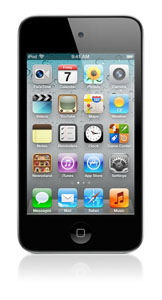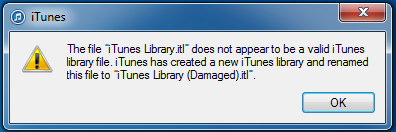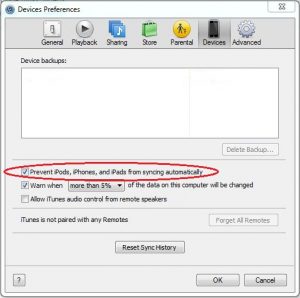 I use both a Macbook and a Windows desktop and wanted to see if I could sync the same iPod Touch to both machines. Below is one method I found to do this and some caveats about the method. (This method will work with iPhones and iPads also.)
I use both a Macbook and a Windows desktop and wanted to see if I could sync the same iPod Touch to both machines. Below is one method I found to do this and some caveats about the method. (This method will work with iPhones and iPads also.)
Some background on how an iPod Touch pairs with an iTunes library
When you install iTunes on any computer, iTunes gets assigned a unique identifier. When you sync an iPod Touch to that same computer, the iPod Touch will store that unique identifier. If you attempt to sync the iPod Touch with another computer, the stored identifier won’t match that of the other computer’s iTunes library and the iPod Touch will refuse to sync. To get the iPod Touch to sync with the other computer, you would have to agree to overwrite the stored unique identifier and content of the iPod Touch with that of the new iTunes library.
Syncing to more than one machine
I found several websites that contained instructions on how to sync an iPod Touch (or iPhone or iPad) to more than one computer. However, the instructions did not work for the latest iTunes 10.5 version. In the comments of How to sync an iPhone with two (or more) Computers, I found a method which worked. While the old method was to change the unique identifier in two files (“iTunes Library.itl” and “iTunes Music Library.xml”), the new method only required changing one file (iTunes Music Library.xml).
- On the first computer (which the iPod Touch currently syncs to), locate the iTunes directory.
- On Windows XP: \Document and Settings\username\My Documents\My Music\iTunes
- On Windows 7: \Users\username\Music\iTunes
- On Mac OS X: /Users/username/Music/iTunes
- Open the “iTunes Music Library.xml” file in your favorite text editor, search for the “Library Persistent ID” key, and copy the key value (a hex string that looks like “8ACF35DDCB78FEB1”).
- On the second computer, locate the iTunes directory.
- Open the “iTunes Music Library.xml” file, search for the “Library Persistent ID” key, and overwrite its value with the value from the first computer.
- Rename (or delete if you are brave) the “iTunes Library.itl” file.
- Create a new “iTunes Library.itl” file with zero size. You must create this file; otherwise, iTunes will generate a new Library Persistent ID without any warning.
 Run iTunes on the second computer, it will throw a warning that the “iTunes Library.itl” file is corrupt and it will then generate a replacement file. (If you don’t get a warning, iTunes will overwrite your inputted Library ID and you will need to start over.)
Run iTunes on the second computer, it will throw a warning that the “iTunes Library.itl” file is corrupt and it will then generate a replacement file. (If you don’t get a warning, iTunes will overwrite your inputted Library ID and you will need to start over.)
- Exit iTunes, open the “iTunes Library.itl” file, and double-check that the Library Persistent ID is still the value you want. (You can delete the “iTunes Library (Damaged).itl” file.)
- Because the iTunes Library was re-generated, you will need to re-add any apps, music, videos, etc. To re-add the content, go to the menu “File->Add File to Library” or “File->Add Folder To Library” and choose the file or folder to add. (The application files with extension “.ipa” are located in the “iTunes Media/Mobile Applications” subdirectory under the iTunes directory.) iTunes will automatically recognized what is being imported.
 The iPod Touch is now sync’able against both computers. But wait, the information (music, video, contacts, notes, etc.) and applications on both computer are likely not identical. If that is the case, you will want to manually control how the sync works on either computer. You can start by configuring iTunes to not automatically sync.
The iPod Touch is now sync’able against both computers. But wait, the information (music, video, contacts, notes, etc.) and applications on both computer are likely not identical. If that is the case, you will want to manually control how the sync works on either computer. You can start by configuring iTunes to not automatically sync.
Run iTunes on both computers and do the following:
- On Mac OS X, go to menu “iTunes->Preferences”. On Windows, go to menu “Edit->Preferences”.
- Select the Devices tab and check the “Prevent iPods, iPhones, and iPads from syncing automatically” option.
- If you would like to control the location where your music and video files are stored, select the Advanced tab and uncheck the “Keep iTunes Media folder organized” and “Copy files to iTunes Media folder when adding to library” options.
- If you would like to prevent automatic downloads from the iTunes store, select the Store tab and uncheck every option (including “Always check for available downloads”).
Doing the above does not solve the whole issue of having different content on the two computers. The problem is that the iPod Touch has its own configuration on what to sync (Apps, Music, Movies, TV Shows, Photos, and Info). To see those sync options (they show as tabs in the device details), connect the iPod Touch to the computer and click on the iPod Touch device in iTunes. If you configure the iPod Touch to sync Music, the same setting is used for both computers and if you don’t have the same music on both computers, then you have an issue.
The workaround I use for the above is manually intensive. Before syncing, I double-check the sync options on the iPod Touch. If I only have music on my first computer, I make sure to check “Sync Music” before syncing; while on the second computer, I make sure to uncheck “Sync Music” before syncing. (Strangely, the “Sync Info” options are not persisted for both computers, but this might be a Mac OS X and Windows side effect.) If I’m careful and don’t get confused, it works. Of course, if I mess up and accidentally get the music wiped from the iPod Touch, it is easy to re-sync the music back.
Of course, you can avoid the above complexity by having the same content exist on both computers. In that case, instead of following the steps above to get sync working with both computers, you might consider copying the “iTunes Library.itl” file over to the second computer and deleting the “iTunes Music Library.xml” file on the second computer. On startup, iTunes will regenerate the “iTunes Music Library.xml” file with the library identifier from the “iTunes Library.itl” file. The content info (stored in “iTunes Library.itl”) will show up in iTunes on the second computer; you will need to have the actual content files, like mp3 music files, exist in the same directory locations. I also read that you could just copy the whole iTunes directory from the first to the second computer, but I have never tried this so don’t know if it will work.
Alternatively, there is a way to sync the content from the iPod Touch to the second computer. This is possible according to Sync iPhone to iTunes – Transfer iPhone to iTunes synchronization. I haven’t tried this, but it looks very interesting and opens up new possibilities.
I hope that the above info will help you to get the most from your iPod Touch.
